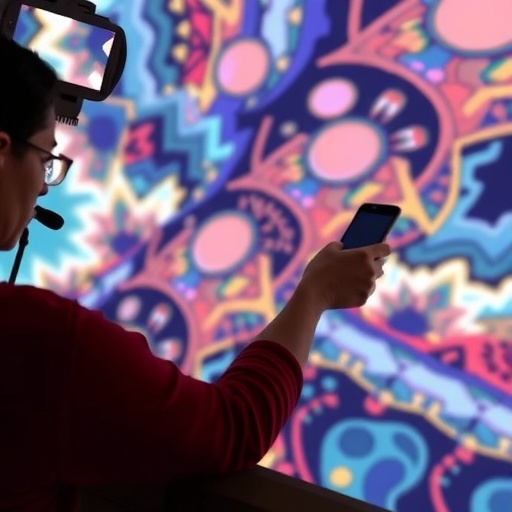In a groundbreaking study published in “Biological Sex Differences,” researchers Coelho, Ramirez, and Basta delve into the intriguing role of visual experience on haptic spatial perception. The extensive research examines blind, late-blind, and sighted individuals, uncovering what differentiates these groups in their perception of space through touch. As the world becomes increasingly reliant on technology that engages our various senses, understanding how these senses interact becomes ever more critical.
Haptic perception—the ability to recognize objects through touch—remains an essential aspect of human interaction with the surroundings. For individuals who are blind, the absence of visual input can entirely shift how they engage with the environment. The research indicates that those who became blind later in life retain some visual memory, which influences how they perceive tactile information. This phenomenon presents a fascinating juxtaposition between those who have never experienced sight and those who transitioned to blindness.
The study involved a range of tasks designed to assess spatial awareness and object recognition among participants. Blind individuals relied on touch to navigate their environment, drawing upon heightened sensitivity in their fingertips and the integration of sensory inputs from other body parts. In contrast, sighted individuals, who predominantly utilize visual cues, displayed a different approach to spatial perception, often relying on visual memory to inform and guide their haptic interactions.
The findings show that early-blind individuals often exhibit a form of haptic expertise rooted in their tactile experiences. Their sensory perception seems to adapt uniquely to compensate for the absence of vision, suggesting that the brain undergoes significant changes to enhance haptic feedback. Conversely, late-blind individuals reported struggles with spatial perception, highlighting the lingering influence of their visual past. This difference underscores the adaptive capability of the human brain and raises questions about the mechanisms behind sensory compensation.
One of the core objectives of this study was to explore the neural correlates underpinning haptic spatial perception. Neuro imaging techniques demonstrated that while blind individuals engage different brain areas than sighted individuals during haptic tasks, they also show increased connectivity in regions associated with tactile processing. This enhanced neural network seems to foster a more profound haptic awareness and may lead to more nuanced object interactions than those typically observed among sighted individuals.
Diving deeper into the implications of these findings, the research prompts educators and technology developers to reconsider how to design tools and environments that foster tactile engagement. For instance, educational curriculums can be adapted to harness the strengths of tactile sensitivity, leading to an enriching experience for blind students. Synthetic environments, augmented reality, and haptic feedback technologies could aid in bridging the gap between visual and tactile information, making learning more accessible.
The study also holds broader societal implications. With a growing recognition of the importance of inclusivity, understanding the interplay between haptic and visual perception offers insights into designing better user interfaces and public spaces for individuals with varying visual capabilities. Companies that prioritize user experience in their products could greatly benefit from integrating these findings into their design strategies, promoting accessibility across their services.
One can envision the future where technology serves not just as a replacement for vision but as a multisensory aid. For example, virtual reality worlds that utilize haptic feedback could allow blind users to create mental maps of physical spaces, empowering them to navigate with more confidence. The potential applications extend beyond gaming or casual entertainment, touching educational tools, rehabilitation methods, and day-to-day navigation systems.
Moreover, the research emphasizes the importance of fostering communities where individuals with different sensory experiences can share their insights. By pooling together experiences, educators and technologists can develop more refined methods that integrate haptic feedback, teaching others about the capabilities of this often-overlooked sense. Collective learning can drive innovation, giving rise to new products and services that not only cater to blind individuals but enhance the experiences of all users.
As we dissect the findings of this research, it becomes evident that human sensory perception is not merely about isolated experiences. Instead, the interaction between the senses profoundly shapes our understanding of the world. The study highlights how experiencing the world through touch can yield a rich internal landscape, foster creativity, and enhance problem-solving abilities. Besides, it illustrates the resilience and adaptability of the human brain and its propensity to repurpose existing neural pathways in response to sensory deprivation.
In conclusion, the research undertaken by Coelho and colleagues is a testament to the complexities of sensory perception and the adaptability of the human spirit. The implications stretch far beyond the academic realm; they challenge societal norms and present new ways to accommodate and appreciate the diverse ways individuals interact with their environment. As we move forward, continued research in this field will undoubtedly unravel further mysteries of human perception, opening doors to innovations that empower everyone, regardless of their sensory experiences.
Subject of Research: The role of visual experience in haptic spatial perception among individuals with different visual experiences.
Article Title: The role of visual experience in haptic spatial perception: evidence from early blind, late blind, and sighted individuals.
Article References:
Coelho, L.A., Ramirez, D.E.A., Basta, S. et al. The role of visual experience in haptic spatial perception: evidence from early blind, late blind, and sighted individuals.
Biol Sex Differ 16, 64 (2025). https://doi.org/10.1186/s13293-025-00747-y
Image Credits: AI Generated
DOI: 10.1186/s13293-025-00747-y
Keywords: Haptic perception, spatial awareness, blind individuals, sensory experience, tactile feedback.




